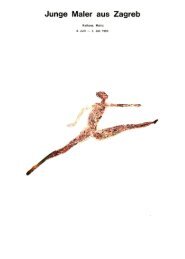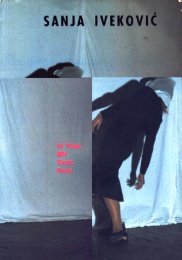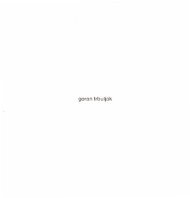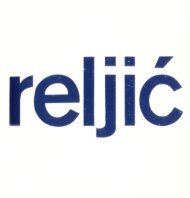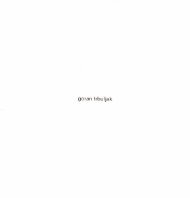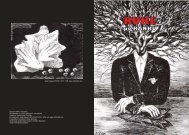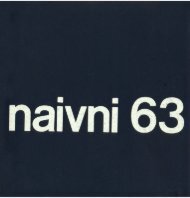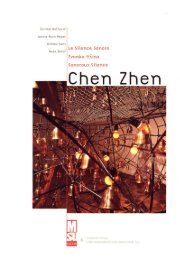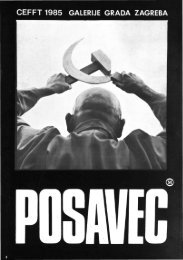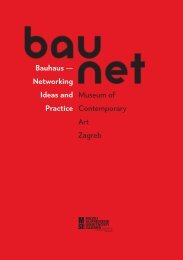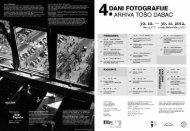The New Art Practice in Yugoslavia, 1966-1978
The New Art Practice in Yugoslavia, 1966-1978
The New Art Practice in Yugoslavia, 1966-1978
- TAGS
- practice
- yugoslavia
- www.msu.hr
You also want an ePaper? Increase the reach of your titles
YUMPU automatically turns print PDFs into web optimized ePapers that Google loves.
Toma Brejc<br />
OHO as an <strong>Art</strong>istic Phenomenon <strong>1966</strong>-1971<br />
Ljubljana<br />
Figs. 1-38<br />
In the Sign of Reism <strong>1966</strong>-1968<br />
OHO is a portmanteau form co<strong>in</strong>ed from the words oko (eye)<br />
and uho (ear). Applied to the field of perception it means the<br />
universal grasp<strong>in</strong>g of phenomena <strong>in</strong> their immediate presence,<br />
i.e. before the experience of pereception becomes the basis<br />
of a different, specifically structured classification. In the field<br />
of art OHO represented <strong>in</strong>itially a descent from tradition<br />
burdened with mean<strong>in</strong>g and a return to the object itself:<br />
Marko Poganik used a simple procedure to make impressions<br />
of utility objects, which, placed <strong>in</strong> a gallery, could be viewed<br />
<strong>in</strong> the light of their actual existence that has been obliterated<br />
because of their utilitarian function (the series Flasks. Fig. 2).<br />
This <strong>in</strong>sistence on the basic, <strong>in</strong>disputably orig<strong>in</strong>al experience of<br />
the object is characteristic of the first works of Marko Poganik,<br />
Milenko Matanovi, Nako Kr<strong>in</strong>ar, and Andra alamun. But<br />
<strong>in</strong>strumental <strong>in</strong> the creation of such a perception of the object<br />
were the poets lztok Geister-Plamen, Franci Zagor<strong>in</strong>ik, and<br />
somewhat later Matja Hanek. This was also the start<strong>in</strong>g po<strong>in</strong>t<br />
of the creative work of Sreo Dragan, while Toma alamun<br />
occasionally appeared as the catalyst of new decisions and<br />
made an important contribution to the creative development<br />
away from objects and their nam<strong>in</strong>g towards different creative<br />
conceptions.<br />
<strong>The</strong> question of how the alienated vision of the world and its<br />
reality could be replaced by a different perception of objects,<br />
of how eye could be tra<strong>in</strong>ed to perceive the beauty of the<br />
immediate presence and existence of the object and the ear to<br />
catch their sound was raised by Toma Salamun when he tried<br />
to describe what was then an almost terrible existence on the<br />
borderl<strong>in</strong>e between the traditional and the OHO-perception of<br />
the object:<br />
Inscrutable are object <strong>in</strong> their cunn<strong>in</strong>g,<br />
unreachable for the wrath of the liv<strong>in</strong>g,<br />
<strong>in</strong>vulnerable <strong>in</strong> cont<strong>in</strong>uous flow,<br />
you can't reach them,<br />
you can't seize them,<br />
motionless <strong>in</strong> their amazement.<br />
Iztok Geister, one of the ma<strong>in</strong> ideologists of the early activity<br />
of OHO, described the transition to the field and level of<br />
objects <strong>in</strong> the OHO manifesto, which he wrote with Marko<br />
Poganik: «Objects are real. We approach the reality of the<br />
object by accept<strong>in</strong>g it such as it is. But what is an object<br />
like? <strong>The</strong> first th<strong>in</strong>g we notice is that it is silent. Still, an<br />
object has a lot to offer! By means of the word we can br<strong>in</strong>g<br />
out the <strong>in</strong>audible voice <strong>in</strong> the object. Only the word hears<br />
that voice. <strong>The</strong> word registers or identifies the sound of the<br />
object. Spech expresses the voice <strong>in</strong>dicated by the word.<br />
Here speech meets with music, which is the voice of the<br />
object that can be perceived by hear<strong>in</strong>g.. In order to rema<strong>in</strong><br />
on the accepted level of the discourse on objects and<br />
with<strong>in</strong> the safe bounds of the reistic tautology, Marko<br />
Poganik had to <strong>in</strong>vent a suitable visual technology by means<br />
of which he could preserve the vision of the immediate presence<br />
of the object, its awareness and perfection <strong>in</strong> mass media:<br />
«Texts are made up of letters. Letters are made up of l<strong>in</strong>es<br />
L<strong>in</strong>es serve the purpose of signall<strong>in</strong>g visually <strong>in</strong>dividual<br />
sounds <strong>in</strong> the form of letters. <strong>The</strong>refore, <strong>in</strong> the case of<br />
texts, the l<strong>in</strong>e is hidden beh<strong>in</strong>d the sound of the letter. How<br />
then can the l<strong>in</strong>e (as the basic element of the page besides<br />
the pr<strong>in</strong>t<strong>in</strong>g-<strong>in</strong>k and paper) be brought to light if not <strong>in</strong> the<br />
form of a draw<strong>in</strong>g? In a draw<strong>in</strong>g the l<strong>in</strong>e stands on its own,<br />
if the draw<strong>in</strong>g is on the level of self consciousness. A draw<strong>in</strong>g<br />
consist<strong>in</strong>g of l<strong>in</strong>es is the <strong>in</strong>dispensable element of the open<br />
pages of newspapers or magaz<strong>in</strong>es. Visual poetry. which is<br />
also called topographic poetry, is the revelation of this<br />
differentiated (visual-sound) role of the l<strong>in</strong>e.. This statement,<br />
which po<strong>in</strong>ts out the significance of the group's experiments<br />
with visual poetry, gives the basic <strong>in</strong>sight <strong>in</strong>to the draw<strong>in</strong>gs<br />
of the OHO group: the draw<strong>in</strong>g, which shows the presence<br />
of the awareness of the object th<strong>in</strong>g and which at the same<br />
time establishes the essential mimetic bear<strong>in</strong>gs, cannot be the<br />
visually rich presentation of the artist's skill or knowledge<br />
about the visual richness of the object th<strong>in</strong>g which must be<br />
drawn. <strong>The</strong> OHO draw<strong>in</strong>g gives only the basic contours for the<br />
identification of the object, the descriptive elements which<br />
are never the <strong>in</strong>tepreters of its essence or functionality,<br />
because the draw<strong>in</strong>g follows only the cont<strong>in</strong>uous trace of the<br />
imag<strong>in</strong>ary l<strong>in</strong>e of the object's presence and noth<strong>in</strong>g more.<br />
All the various levels of letters, objects, moods, visions are<br />
connected and levelled up by the universal thread of the OHO<br />
draw<strong>in</strong>g. However, we must ask: where does the draw<strong>in</strong>g take<br />
place? On the sheet of paper, on the page of the magaz<strong>in</strong>e<br />
or the newspaper but what is the attitude of that space<br />
<strong>in</strong> relation to the effect of the OHO draw<strong>in</strong>g? <strong>The</strong> OHO<br />
manifesto makes the follow<strong>in</strong>g statement: «When does the<br />
space dis<strong>in</strong>tegrate <strong>in</strong>to free perception? As soon as I write this,<br />
which means <strong>in</strong>stantly or simultaneously. When I liberate<br />
space so that it becomes free perception, which means<br />
<strong>in</strong>stantly and simultaneously. But <strong>in</strong> the idea there exists a<br />
space which is empty, free <strong>in</strong> the sense that there is<br />
noth<strong>in</strong>g there. If the situation is such that noth<strong>in</strong>g is there,<br />
what is it? It is, then, not possible to take a stand or to<br />
occupy space because of the presence of noth<strong>in</strong>g, <strong>in</strong> order<br />
that there should be someth<strong>in</strong>g there, if someth<strong>in</strong>g exists<br />
there from the moment when noth<strong>in</strong>g is there ... Is any<br />
commitment possible <strong>in</strong> space? It is not, because space itself<br />
is committed <strong>in</strong> its freedom. What does it do <strong>in</strong> its freedom?<br />
It observes. To observe, to see oneself means to be free.<br />
To observe, to look elsewhere, further from oneself, means<br />
to be <strong>in</strong> a relationship or a dichotomy. <strong>The</strong> absolute and the<br />
relative have noth<strong>in</strong>g <strong>in</strong> common. <strong>The</strong> one excludes the other.<br />
Free perception is the absolute perception. Conquerors of<br />
space stand <strong>in</strong> a certa<strong>in</strong> relationship to space. Thus they are<br />
situated neither <strong>in</strong> themselves nor <strong>in</strong> the space they have<br />
taken up.» S<strong>in</strong>ce this is not the place to enter <strong>in</strong>to the<br />
philosophical nature of this statement, which leans on the<br />
debates of that period about Sartre, Husserl and Heidegger,<br />
nor <strong>in</strong>to the political connotations of the term conquerors of<br />
space, we shall centre our attenticn on space as seen by the<br />
OHO group, for whom it was also determ<strong>in</strong>ed by the same<br />
reistic tautology. S<strong>in</strong>ce the draw<strong>in</strong>g and the background on<br />
which it exists are two separate entities, be<strong>in</strong>g autonomous<br />
and <strong>in</strong>dependent, their <strong>in</strong>terrelationship is necessarily<br />
quantitative, so that the shadow of the object cannot appear<br />
<strong>in</strong> the same field: not because it does not exist, but simply<br />
because there is no relative, <strong>in</strong>terrelated space <strong>in</strong> which the<br />
shadow could be situated. <strong>The</strong> shadow as such should have<br />
the same phenomenological value and could not be a<br />
redundant piece of <strong>in</strong>formation about the actual location of<br />
object <strong>in</strong>, for example, perspective space. But s<strong>in</strong>ce objects<br />
exist both as autonomous data and <strong>in</strong>n relation to space that<br />
surrounds them and s<strong>in</strong>ce <strong>in</strong> relation to objects perceived <strong>in</strong><br />
that way space is also an autonomous piece of <strong>in</strong>formation,<br />
the OHO draw<strong>in</strong>g centres on the objects themselves: their<br />
awakened presence radiates <strong>in</strong>to the space, objectiviz<strong>in</strong>g it.<br />
This rather simple topology requires only a rigorous<br />
selectivity by means of sight and hear<strong>in</strong>g <strong>in</strong> relation to the<br />
multitude of phenomenological objects, but at the moment<br />
when the act of draw<strong>in</strong>g and the act of listen<strong>in</strong>g are <strong>in</strong><br />
progress, there arise experiences which have noth<strong>in</strong>g to do<br />
with the everydy classification of objects accord<strong>in</strong>g to<br />
mean<strong>in</strong>g. function and space. <strong>The</strong> reistic democracy of object<br />
hood requires therefore a shift from <strong>in</strong>terpretation to<br />
observation. <strong>The</strong> procedural method was expla<strong>in</strong>ed by Iztok<br />
Geister: «Above sense and nonsense is the object ivization. <strong>The</strong><br />
objectivization is the scientific research <strong>in</strong>to and observation of<br />
objects. Hence the standardization of the appearance of the<br />
various qualities and types of objects and the disappearance<br />
of the illusionistic space, <strong>in</strong> which objects can be registered<br />
accord<strong>in</strong>g to their utility or ideological value.<br />
<strong>The</strong> first visual realization of the name 01-10 was Marko's<br />
draw<strong>in</strong>g <strong>in</strong> which he records the sensory presence of beats<br />
and sounds. His Book (<strong>1966</strong>) consists of 27 punched pages, <strong>in</strong><br />
which holes of vary<strong>in</strong>g diameters are placed <strong>in</strong> such a way as<br />
to create the impression of a truly plastic object. This marks<br />
the beg<strong>in</strong>n<strong>in</strong>g of a series of books, which has been analysed<br />
<strong>in</strong> detail by Rastko Monik. <strong>The</strong>y were simple, small books or<br />
boxes, whose pages bore impressions of various objects<br />
13



